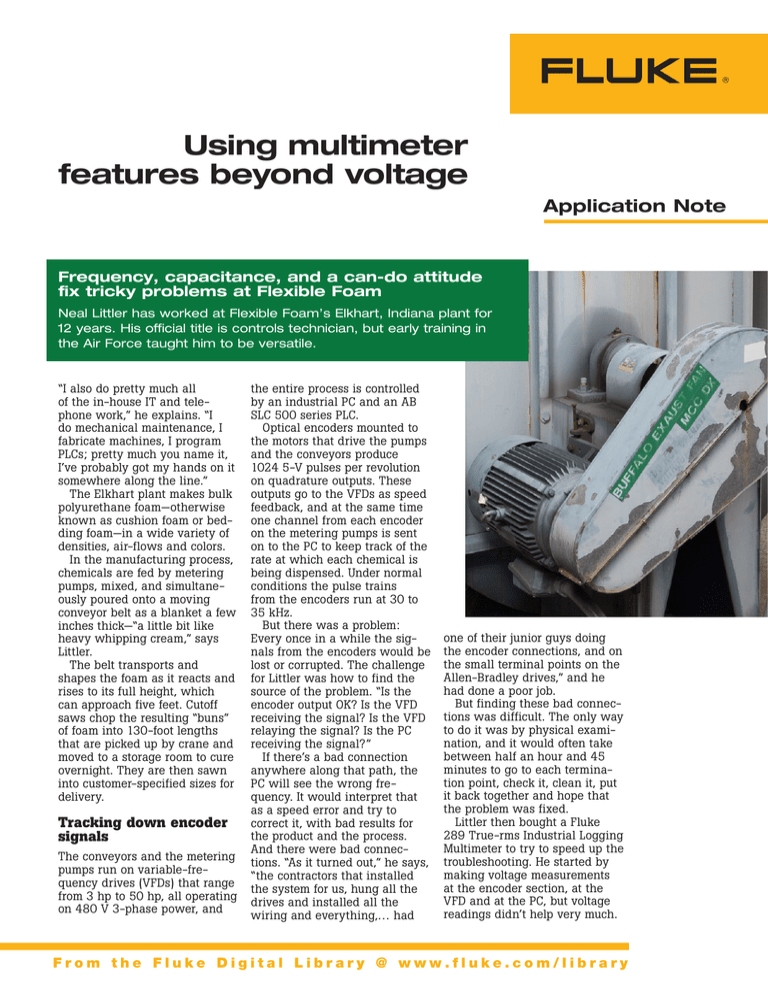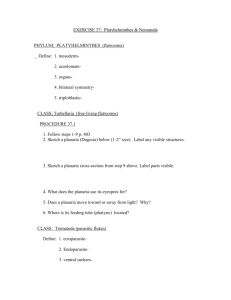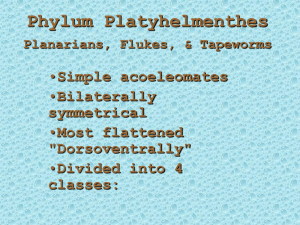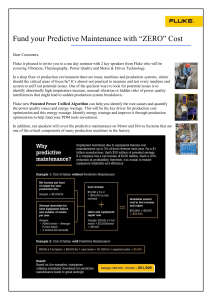Using multimeter features beyond voltage
advertisement

Using multimeter features beyond voltage Application Note Frequency, capacitance, and a can-do attitude fix tricky problems at Flexible Foam Neal Littler has worked at Flexible Foam’s Elkhart, Indiana plant for 12 years. His official title is controls technician, but early training in the Air Force taught him to be versatile. “I also do pretty much all of the in-house IT and telephone work,” he explains. “I do mechanical maintenance, I fabricate machines, I program PLCs; pretty much you name it, I’ve probably got my hands on it somewhere along the line.” The Elkhart plant makes bulk polyurethane foam—otherwise known as cushion foam or bedding foam—in a wide variety of densities, air-flows and colors. In the manufacturing process, chemicals are fed by metering pumps, mixed, and simultaneously poured onto a moving conveyor belt as a blanket a few inches thick—“a little bit like heavy whipping cream,” says Littler. The belt transports and shapes the foam as it reacts and rises to its full height, which can approach five feet. Cutoff saws chop the resulting “buns” of foam into 130-foot lengths that are picked up by crane and moved to a storage room to cure overnight. They are then sawn into customer-specified sizes for delivery. Tracking down encoder signals The conveyors and the metering pumps run on variable-frequency drives (VFDs) that range from 3 hp to 50 hp, all operating on 480 V 3-phase power, and the entire process is controlled by an industrial PC and an AB SLC 500 series PLC. Optical encoders mounted to the motors that drive the pumps and the conveyors produce 1024 5-V pulses per revolution on quadrature outputs. These outputs go to the VFDs as speed feedback, and at the same time one channel from each encoder on the metering pumps is sent on to the PC to keep track of the rate at which each chemical is being dispensed. Under normal conditions the pulse trains from the encoders run at 30 to 35 kHz. But there was a problem: Every once in a while the signals from the encoders would be lost or corrupted. The challenge for Littler was how to find the source of the problem. “Is the encoder output OK? Is the VFD receiving the signal? Is the VFD relaying the signal? Is the PC receiving the signal?” If there’s a bad connection anywhere along that path, the PC will see the wrong frequency. It would interpret that as a speed error and try to correct it, with bad results for the product and the process. And there were bad connections. “As it turned out,” he says, “the contractors that installed the system for us, hung all the drives and installed all the wiring and everything,… had one of their junior guys doing the encoder connections, and on the small terminal points on the Allen-Bradley drives,” and he had done a poor job. But finding these bad connections was difficult. The only way to do it was by physical examination, and it would often take between half an hour and 45 minutes to go to each termination point, check it, clean it, put it back together and hope that the problem was fixed. Littler then bought a Fluke 289 True-rms Industrial Logging Multimeter to try to speed up the troubleshooting. He started by making voltage measurements at the encoder section, at the VFD and at the PC, but voltage readings didn’t help very much. From the Fluke Digital Library @ www.fluke.com/library “Sometimes I would be able to see a voltage coming back,” he says, “but that didn’t necessarily mean that all the pulses were coming through.” He then got the idea of switching the 289’s mode to measure frequency instead of voltage. Knowing that the encoders produce 1024 pulses per revolution, and knowing the set speed for each motor, it was a simple calculation to find what the output frequency of each encoder should be. This led to a systematic troubleshooting procedure: First he checks the signal as it comes out of the encoder. “If what I’m reading matches what the drive says it’s running RPM-wise within a few RPM,” he explains, “I’m reasonably sure that the signal is OK up to that point.” He then follows the train on to the buffer card that receives the signal from the VFD and takes it into the PC, and repeats the measurement. With the Fluke 289, it takes just a couple of quick checks at a couple of key points to zero in on the problem spots. “Using the 289,” he says, “I’ve been able to crunch that troubleshooting time down to just a few minutes.” Not all the problems come from bad connections, of course. Once in a while an encoder will lose one channel. “And here again, isolating and troubleshooting that without some way of truly reading the encoder signal proved to be a little hit-or-miss on occasion,” Littler says. But the 289’s frequency measurement capability makes it quick and easy to go straight to the drive and check each of the lines from the encoder. Within a few seconds he can tell if the encoder is bad or a wire had been damaged, “but either way it makes the troubleshooting process much quicker and simpler.” Why are the SCRs blowing? Not all the drives in the plant are ac; there is also a 40 hp dc drive running a conveyor, and every so often its SCRs (silicon controlled rectifier, or thyristor) would suddenly blow for no apparent reason. Littler would replace the SCRs, he says, “and it would run fine for, say, a month, and all of a sudden it would just blow out again and there was no rhyme or reason to why it was doing it.” The drive uses 12 SCRs, and they never failed one at a time; “it usually averaged out to be about half the SCRs would go when one went. And by the time those half went, that’s usually when the fuses would blow.” And the SCRs cost about $85 each. One day, while he was tearing the drive apart and replacing the SRCs in it yet again, he decided to check some other things, just on a what-if scenario. “There’s nothing obviously wrong, maybe I’m missing something,” he explains. The drive has a set of large filter capacitors, and he decided to measure their capacitance with his 289. “Sure enough,” he explains, “one of them was reading 50 % of what the other ones did. And that, obviously, was kind of a bright red light bulb that came on.” He contacted the manufacturer of the drive and described what he had found to a technician, who responded that an off-value capacitor could indeed cause the problem he was seeing. “So they sent me a new capacitor to replace the bad one and it’s been running great ever since.” A long-time Fluke user Littler has had many Fluke meters over the years: “I started off with a Fluke 77 in the service and I’ve gone through a 27, 79, an 87, an 89 and now currently my 289, and not one of those meters failed on me,” he says. “It was always a want or a need to upgrade to a newer meter with more features on it.” He did once try another brand, he goes on. He was looking for a plug-in current clamp, and chose a lower-price unit. “It didn’t even last six months,” he says. “Absolutely hopelessly dead.” Taking that as a lesson, he bought a Fluke add-on clamp, and has been using it for eight years. “It’s still going strong, and not a thing wrong with it.” While he’s not necessarily kind to his equipment, he doesn’t beat them to death either. “I take care of my equipment but at the same time I work in an industrial facility, so they get a certain amount of banging around,” he explains. “I’ve never been able to destroy a Fluke meter, no matter how badly I mistreat it.” Fluke. Keeping your world up and running.® Fluke Corporation PO Box 9090, Everett, WA 98206 U.S.A. Fluke Europe B.V. PO Box 1186, 5602 BD Eindhoven, The Netherlands For more information call: In the U.S.A. (800) 443-5853 or Fax (425) 446-5116 In Europe/M-East/Africa +31 (0) 40 2675 200 or Fax +31 (0) 40 2675 222 In Canada (800)-36-FLUKE or Fax (905) 890-6866 From other countries +1 (425) 446-5500 or Fax +1 (425) 446-5116 Web access: http://www.fluke.com ©2010 Fluke Corporation. Specifications subject to change without notice. Printed in U.S.A. 1/2010 3610968A A-EN-N Modification of this document is not permitted without written permission from Fluke Corporation. 2 Fluke Corporation Using multimeter features beyond voltage






